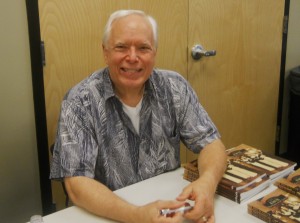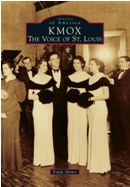Share the post "Frank Absher and his new book KMOX: The Voice of Saint Louis"
Frank Absher and his new book KMOX: The Voice of Saint Louis
by Diana Davis, Walrus Contributor

Frank Absher
Radio fans flocked to the St. Charles City/County Library, Spencer Road Branch on June 12th for a lecture and slide presentation on the early days of radio presented by Frank Absher, a former announcer of KMOX. In 2011, Absher founded the St. Louis Media History Foundation, a not-for-profit organization dedicated to collecting and preserving St. Louis media history. Left Bank Books describes Absher’s new book KMOX: The Voice of St. Louis this way –
“Since it signed on the air on December 24, 1925, KMOX has literally been the “Voice of St. Louis,” a pace setter for the radio industry. That positioning statement perfectly described KMOX’s mission, defining a station that has won every major broadcast award imaginable and directly reflecting its influence. Local author Frank Absher, a former announcer on KMOX, began assembling St. Louis media history in 1987 and shares KMOX’s story in this book.”
Absher, wearing khaki pants and a gray Hawaiian print shirt, came in with a smile, a friendly manner, and a well-modulated, cultured voice. He announced that KMOX, the Voice of St. Louis was his first book, recording the early days of St. Louis radio and he has another one scheduled to be out in November. His tenure with KMOX began in 1979 when he became the announcer on a program titled, “At Your Service” which ran until he left in 1983. What follows are some of the wonderful stories about the history of KMOX, Absher has included in his book.
KMOX was not the first radio station in St. Louis. The first radio stations here were WEW, run by St. Louis University; and KSD, run by the Pulitzer Company; then there were a flood of others. Many stations were church related: KFUO, run by the Lutherans; WMAY, run by the Kingshighway Presbyterian Church, and KFQA, run by The Principia. There was even a radio station called WCK Stix, run by Stix, Baer and Fuller, which later changed its name to WSBF.
Then in 1925, a group of businessmen decided that they wanted to build a radio station to promote city growth, so they founded KMOX, The Voice of St. Louis. It had twin towers to hold up its antennas out in Kirkwood on acreage known as Jelly Roll Hill, which was North of Manchester. Its first studios were in the Hotel Mayfair, downtown. The station operated with 5,000 watts of power, making it an elite station in the nation.
In 1931, CBS bought out the station, built cavernous studios in the Mart Building downtown, and constructed new transmission towers, increasing the power from 5,000 to 50,000 watts. CBS set succeeded in making St. Louis a broadcasting hub. They had studios that recorded shows for all types of interests, including some for housewives. They offered free cookbooks to find out who their listeners were so that they could secure advertisers of household products. Businesses boomed. Shows originating in St. Louis were broadcast all over the country.
 The station had a house band and in those days. Everybody dressed the part that they were playing. For example, at the Christmas Eve soirée, there were three girls from Salem, Illinois, who had formed a group called the Harmonettes. They wore evening gowns and carried little muffs on their hands and the men wore tuxedos, so that they would present an authentic ambiance. Absher used this photo as the cover for his book.
The station had a house band and in those days. Everybody dressed the part that they were playing. For example, at the Christmas Eve soirée, there were three girls from Salem, Illinois, who had formed a group called the Harmonettes. They wore evening gowns and carried little muffs on their hands and the men wore tuxedos, so that they would present an authentic ambiance. Absher used this photo as the cover for his book.
The center girl in the photo was Jean Chassels. She became a well-known radio singer. On the show, she met a guy at the station who was also interested in music. She married him and he got a better job offer from KSD. He took the position. KMOX said that they could not have her working there if her husband worked for the competitor, so in 1938, Jean gave up her singing career on KMOX. She had become Mrs. Russ David.
There were many other stories from the early radio days as well. Jimmie Pierson and Dick Klasi were known as The Novelty Boys. Jimmie was born and raised in Kansas and would sing, yodel and strum his “geetar” in accompaniment, doing the songs of the day. Dick Klasi had the similar routine, but he sang and played the accordion. They arrived in St. Louis in the spring of 1934 and stayed until 1937.
Big band dance music programs were also hits during the great depression and the years following it. People did not have expendable income so they stayed home and listened to radio. The Al Roth Orchestra broadcast from Majestic Gardens for KMOX. KMOX also had its own house band. Pappy Cheshire, who ran it, divided up his musicians to perform at different studios, so he could cover several broadcasts at one time.
In sports, KMOX broadcast the Cardinals and the Browns. France Laux was the Sports Voice of St. Louis. Laux, who had excelled in baseball, football, basketball and track, was extremely knowledgeable about baseball. He was brought to St. Louis in the spring of 1929 and was the sports announcer for years. One day, a guest for his program did not show up. Laux’s producers knew that Mr. Sol Williams, the African-American custodian, loved the sport and had lots of opinions, so he ran out and asked Williams to come and be Laux’s guest. When Laux looked up and saw him coming through the door, he said, “and our guest for the evening is the celebrated sports authority, Sol Williams.” The listeners loved William’s wit and humor, and he became a regular guest.
Forty years later, Miss Miriam Blue stepped onto the Jack Carney show in a like manner. Again, listener response was immediate. In 1975, Miss Blue became a celebrity and had a regular spot twice a week on his show. She joined the broadcaster’s union, AFTRA, and was paid for her broadcast appearances. She continued until her death from a stroke in the early 80s.
Harry Carabina shortened his name to Harry Carey as he entered the media world. He became as announcer for KMOX sports in 1954. He proved as successful in selling beer as he did in selling the Cardinals. He worked at KMOX until 1969 when he was unexpectedly fired as the lead broadcaster. A member of the audience asked Absher why Harry had been fired. Absher replied that some say it was because a reportedly inebriated Carey was struck by a car while trying to cross Kingshighway. He was nearly killed and suffered two broken legs in the accident. Others, including a former wife, have said it was because he had an affair with a daughter-in-law of Auggie Busch, Jr, who owned the brewery. Neither rumor was ever substantiated, and Carey neither denied or affirmed the rumors. His being fired opened the place for his announcing partner, Jack Buck, to move up to the starring role. But that is a story for another time.
Absher threw out more facts and names than could possibly be mentioned in this report. His book, KMOX, the Voice of St. Louis, has over 100 pages covered with old photos of radio personalities with tidbits of information by each photo. If you’re interested in radio, this is a must-read, and you’ll look forward to his next books as well. Absher is passionate about his subject and presents information as only an insider can.



